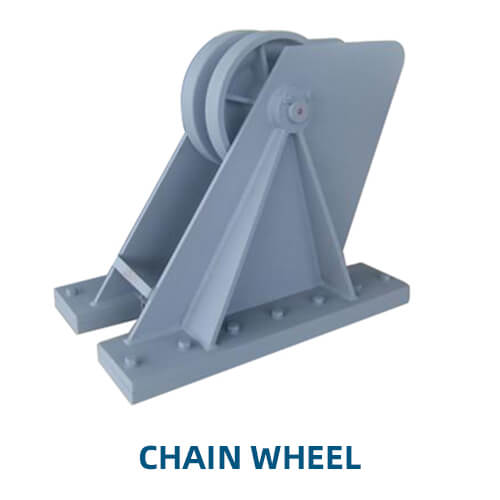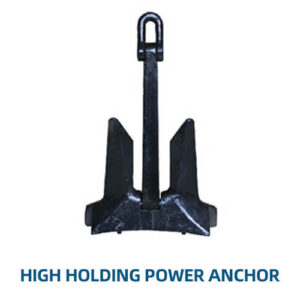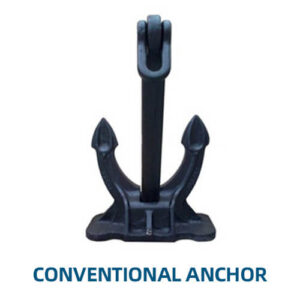Key Features of Chain Wheels:
- Design and Construction:
- Teeth: The wheel is equipped with a series of teeth that are precisely machined to fit the chain links. The teeth are typically designed to engage with the chain securely, ensuring smooth operation and minimal slippage.
- Material: Chain wheels are usually made from high-strength materials such as cast iron, steel, or stainless steel, which provide durability and resistance to wear and corrosion, especially in marine environments.
- Hub and Bore: The central part of the chain wheel, known as the hub, is designed to be mounted on a shaft. The bore, or central hole, is often customized to fit specific shaft sizes and may include keyways or set screws for secure attachment.
- Types:
- Single-Strand Chain Wheel: Designed for use with single chains, this is the most common type, used in applications where a single chain is sufficient to transmit the required load.
- Double or Multiple-Strand Chain Wheel: Used in applications requiring greater power transmission, these chain wheels accommodate two or more parallel chains.
- Tapered Chain Wheel: Features a conical shape that helps in guiding and aligning the chain during operation, often used in specialized applications.
- Applications:
- Anchor Windlasses: Chain wheels are integral components of anchor windlasses, where they engage with the anchor chain to raise and lower the anchor smoothly.
- Capstans: Used in capstans to manage mooring lines or chains, facilitating the handling of heavy loads during docking and anchoring operations.
- Industrial Machinery: In addition to marine applications, chain wheels are used in various industrial machinery, including conveyor systems, hoists, and other chain-driven equipment.
- Performance and Benefits:
- Efficient Power Transmission: Chain wheels provide a reliable means of transmitting power and motion, ensuring that the connected components move in sync and with minimal energy loss.
- Durability: Made from high-quality materials, chain wheels are designed to withstand significant stress and wear, making them suitable for heavy-duty applications.
- Precision: The design and machining of the teeth ensure precise engagement with the chain, reducing the risk of slippage and ensuring smooth operation.
- Maintenance and Care:
- Inspection: Regularly inspect the chain wheel for signs of wear, such as worn teeth, cracks, or deformation. Early detection of wear can prevent more severe damage and prolong the life of the chain wheel.
- Lubrication: Proper lubrication of the chain and the wheel’s engagement points is crucial to reduce friction and wear. Use marine-grade lubricants to protect against corrosion and ensure smooth operation.
- Cleaning: Periodically clean the chain wheel to remove dirt, debris, and salt deposits that could accelerate wear or cause the chain to slip.
- Safety Considerations:
- Proper Alignment: Ensure that the chain wheel is correctly aligned with the chain to prevent uneven wear and reduce the risk of chain derailment or breakage.
- Load Capacity: Always use a chain wheel that is rated for the specific load and application. Overloading can lead to premature wear or failure of the chain or wheel.
- Secure Mounting: Ensure that the chain wheel is securely mounted on the shaft, with all set screws, keyways, or other securing mechanisms properly engaged.
Advantages of Chain Wheels:
- Reliable Power Transmission: Chain wheels are highly efficient at transmitting power and motion, ensuring smooth and synchronized operation in chain-driven systems.
- Durability: Constructed from robust materials, chain wheels are capable of withstanding heavy loads and harsh conditions, making them suitable for marine and industrial applications.
- Versatility: Available in various sizes, materials, and designs, chain wheels can be adapted to a wide range of applications, from marine to industrial machinery.
Considerations for Chain Wheels:
- Material Selection: Choose the appropriate material based on the operating environment. For marine applications, corrosion-resistant materials like stainless steel are recommended.
- Regular Maintenance: To ensure long-term performance, regularly inspect and maintain the chain wheel and the associated chain. Proper lubrication and alignment are essential for preventing wear and ensuring smooth operation.
- Application-Specific Design: Ensure that the chain wheel is designed or selected to match the specific requirements of the application, including load capacity, chain size, and environmental conditions.
Chain wheels are essential components in chain-driven systems, offering reliable power transmission and durability in demanding environments. Their precision design and construction make them indispensable in both marine and industrial applications, where they contribute to the efficient operation of machinery and equipment.






